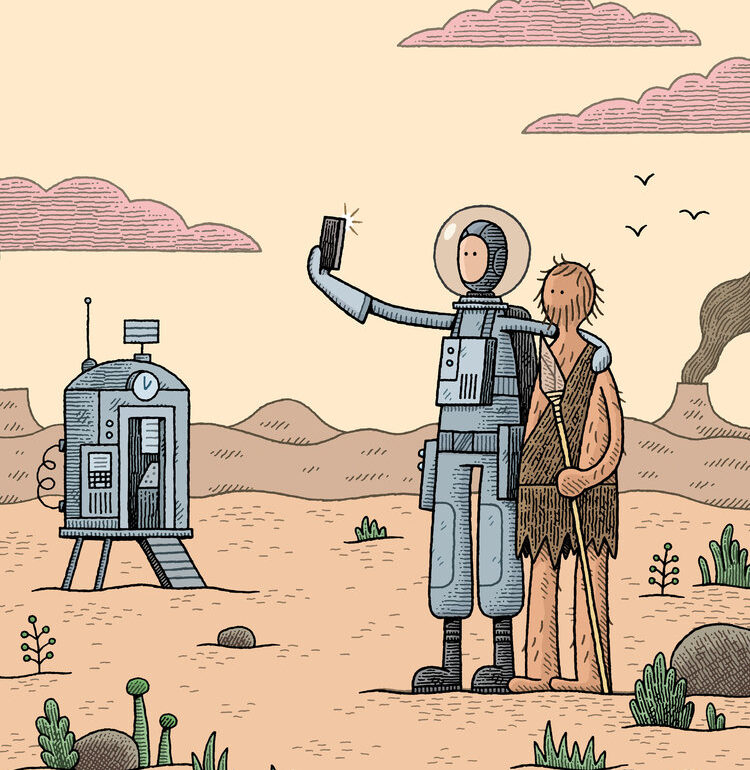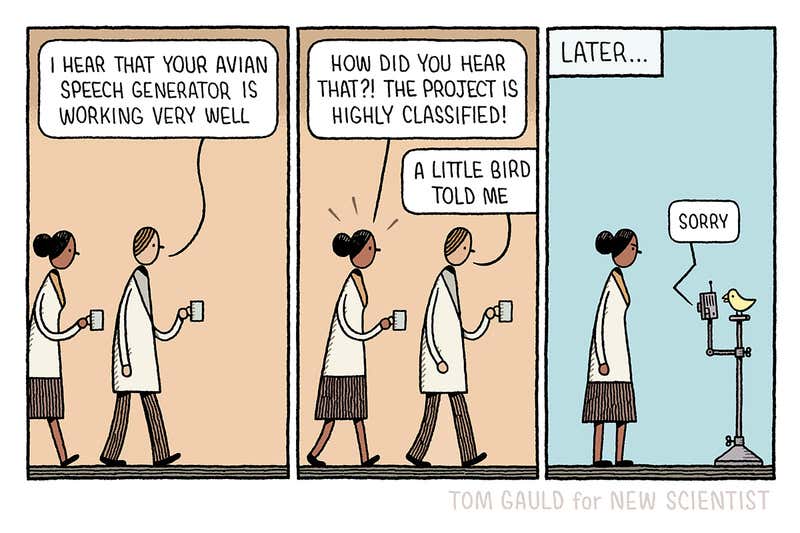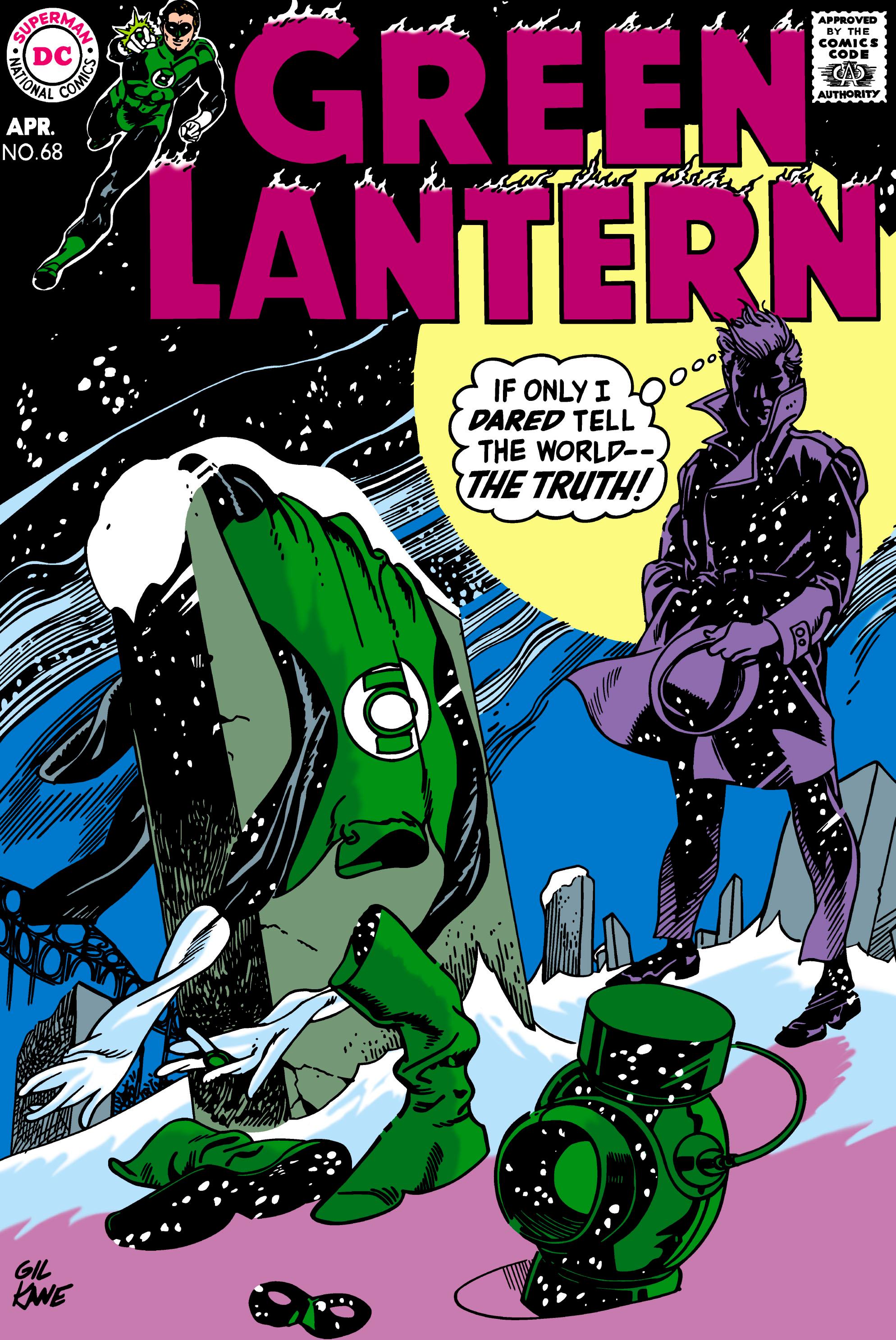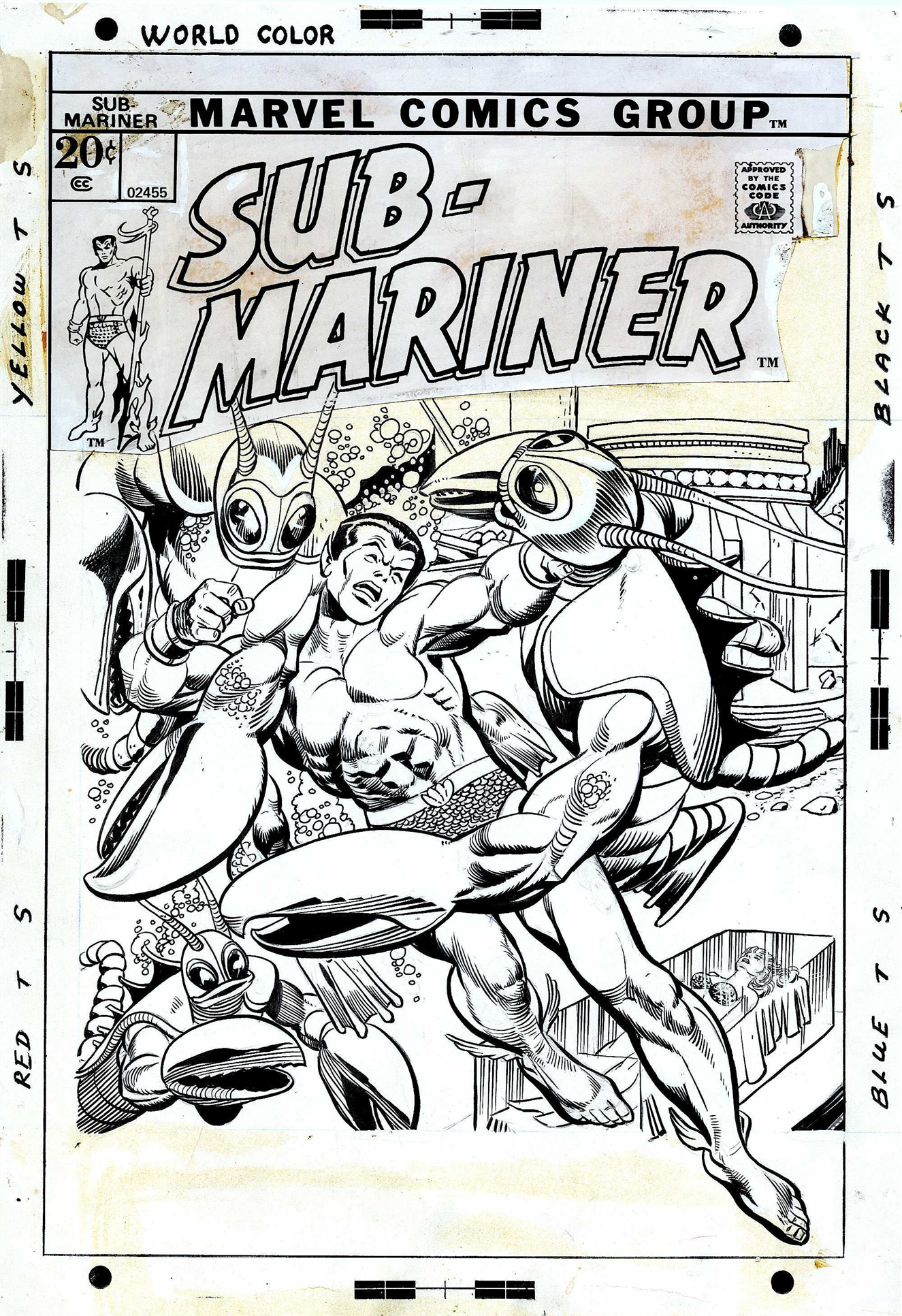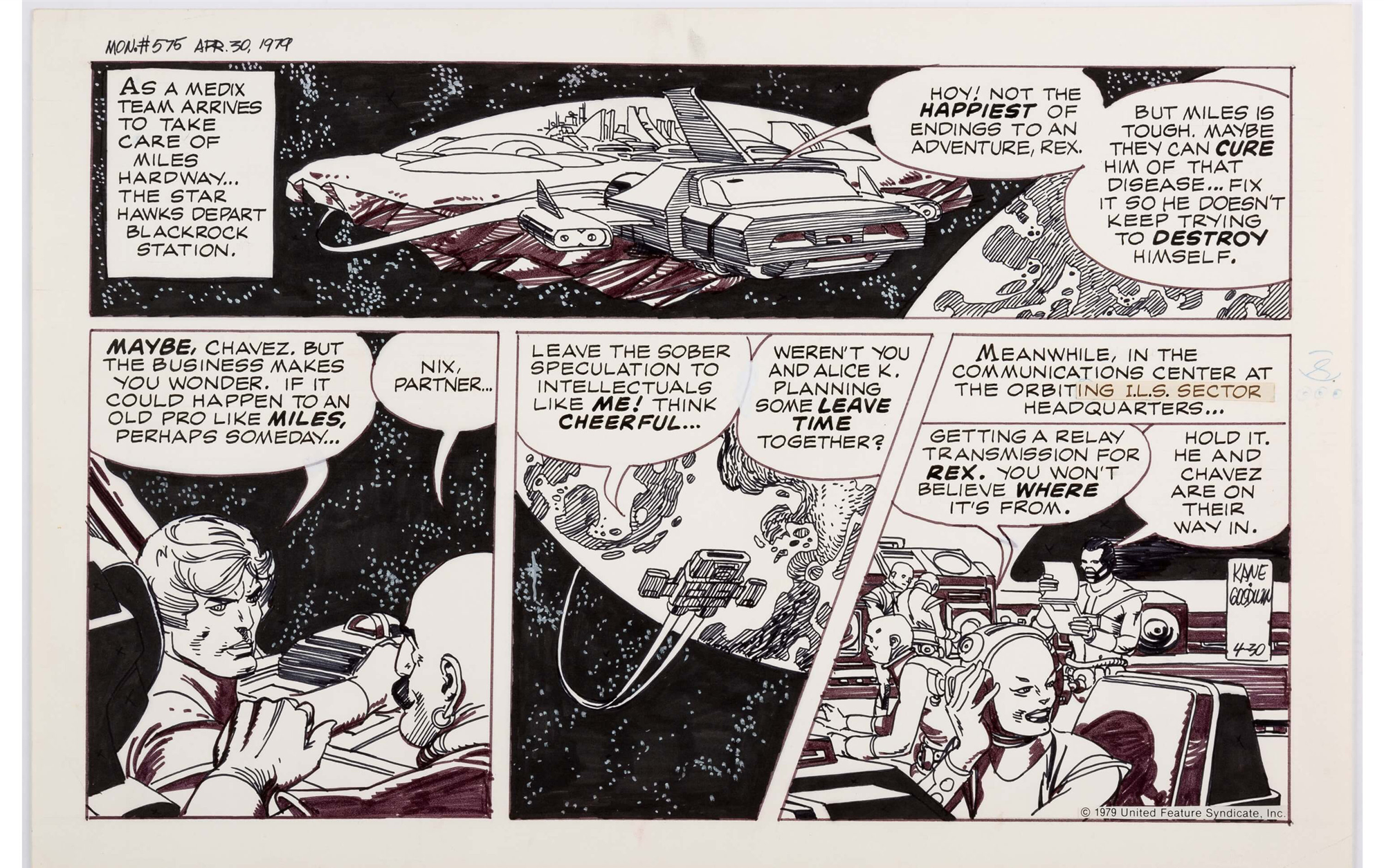
Many different kinds of comics this week at the Club! (Above: Tom Gauld gives us a Time Traveler’s selfie with a caveman! Where would you go if you could time-travel?)
 Aw Yeah Comics! Art Baltazar’s been drawing cartoons for over two decades! He specializes in goofy, all-ages caricatures of established superheroes like the Teen Titans and Superman, but he also tells stories about his own creations, including Action Cat and Adventure Bug, Amazing Mouse, Meteor Mite, and Patrick the Wolf Boy. (There’s even a sweet autobiographical comic strip, “Rose and Art’s First Date.”) Baltazar’s website is a must-visit: scroll down the main page for a bunch of video interviews with Baltazar and blasts of his explosive creativity. (Does he really decorate fire hydrants to look like superheroes?) And be sure to check out Baltazar’s illustrations, paintings, and portfolio!
Aw Yeah Comics! Art Baltazar’s been drawing cartoons for over two decades! He specializes in goofy, all-ages caricatures of established superheroes like the Teen Titans and Superman, but he also tells stories about his own creations, including Action Cat and Adventure Bug, Amazing Mouse, Meteor Mite, and Patrick the Wolf Boy. (There’s even a sweet autobiographical comic strip, “Rose and Art’s First Date.”) Baltazar’s website is a must-visit: scroll down the main page for a bunch of video interviews with Baltazar and blasts of his explosive creativity. (Does he really decorate fire hydrants to look like superheroes?) And be sure to check out Baltazar’s illustrations, paintings, and portfolio!

Take a dive into the Smithsonian Institution’s website, which—through its Learning Lab—provides access to more than a million “educational experiences.” A good place to start is the “Fun Stuff for Kids and Teens” page, full of games and activities. Check out live video streams of animals (including cheetah cubs and a group of naked mole rats) from the National Zoo, a template for making a comic book about nature conservation, resources involving the Folkways music collection at the Smithsonian, and much, much more. And if you scroll down the “Fun Stuff” page, you’ll find virtual exhibits of American “Art, History, and Culture,” including “The Art of Rock and Roll,” a collection of gnarly and historically important skateboards, and a tribute to superheroes, in memory of Stan Lee.
Tom Gauld is a Scottish cartoonist whose minimal visuals and silly-yet-erudite sense of humor make for a winning combination. Enjoy the 30+ cartoons Gauld’s drawn for New Scientist currently available online (including the one above, titled “Tom Gauld’s highly classified avian speech generator project gets out”) and then head over to his website, which features more cartoons and a portfolio section. Lots of fun pictures and strips on Gauld’s Instagram too!
For readers of teen age and older, acquainted with American history: designer Steven Heller has an article at the Design Observer website about Annie Lucasta Rogers (1879-1952), who published her cartoons about the Women’s Movement under the name “Lou” Rogers, so as to fit better into the male-dominated newspaper industry of the early twentieth century. As Heller writes about Rogers: “She belonged to the Heterodoxy group of utopian and radical feminists whose militant protests were in the front line of liberation orthodoxy, often landing them in jail, suffering beatings from police.” Heller writes more about other cartoonists—and about the intersections among visual culture, society and politics—at his “Daily Heller” column at the Print Magazine site. Sample Heller on a socially-distanced exhibition about legendary graphic designer Milton Glazer; on his first encounter with a 1960s underground newspaper; and on Bill Maudlin, World War II cartoon hero and postwar editorial cartoonist.
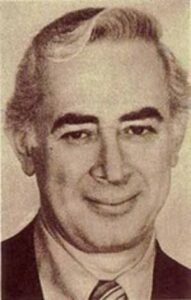 I can’t think of a comic book artist who worked at more companies and on more characters than Gil Kane. Born in 1926 in Riga, Latvia, Kane (whose original name was Eli Kacz), Kane emigrated with parents Max and Helen to New York City in 1930, settling in the Brownsville section of Brooklyn, a poor Jewish neighborhood. As a child, Kane fell in love with American popular culture—Hollywood movies, comic strips, pulp fiction—and quickly discovered his own nascent talent as a visual storyteller as a student at the School of Industrial Art (now New York’s High School of Art and Design).
I can’t think of a comic book artist who worked at more companies and on more characters than Gil Kane. Born in 1926 in Riga, Latvia, Kane (whose original name was Eli Kacz), Kane emigrated with parents Max and Helen to New York City in 1930, settling in the Brownsville section of Brooklyn, a poor Jewish neighborhood. As a child, Kane fell in love with American popular culture—Hollywood movies, comic strips, pulp fiction—and quickly discovered his own nascent talent as a visual storyteller as a student at the School of Industrial Art (now New York’s High School of Art and Design).
To do justice to Kane in this small space is impossible: consult the long-but-still-incomplete bibliography in his Wikipedia entry for more information. But highlights of his career include a 1960s run on the DC superhero Green Lantern, early attempts at the “graphic novel” with His Name is…Savage! (1968) and Blackmark (1971), a memorable 1970s stint on Marvel’s Spider-Man (where he drew the death of Gwen Stacy, Peter Parker’s girlfriend), and a comics adaptation of Richard Wagner’s opera The Ring of the Nibelung (1989-90). In a terrifically detailed survey of Kane’s life and achievements in Comic Book Creator #11 (2016), Jon B. Cooke wrote, “Gil Kane aimed for personal excellence.” A few examples of that excellence are below, and you can find more on two Pinterest collections of Kane art: One, Two.
This weekly blog post is written and compiled by Craig Fischer. To send along recommendations, ideas, and comments, contact Craig at [email protected] [.]

